————————-
Hi there folks! Comments box at the bottom of the page. Comments welcome!!!
————————-
…Fine, clear, dazzling morning, the sun an hour high, the air just tart enough. What a stamp in advance my whole day receives from the song of that meadow lark perch’d on a fence-stake twenty rods distant! Two or three liquid-simple notes, repeated at intervals, full of careless happiness and hope. With its peculiar shimmering slow progress and rapid-noiseless action of the wings, it flies on a way, lights on another stake, and so on to another, shimmering and singing many minutes…
Walt Whitman, A Meadowlark
Desire is perhaps Bob Dylan’s most varied album in terms of style and tone. It combines epic ‘story songs’ about real or fictional characters with a number of shorter and more abstract pieces. The album was recorded with the rhythm section which would become the basis of the Rolling Thunder tour band, with Rob Stoner on bass and Howard Wyeth on drums. The most crucial addition was the eccentric street musician Scarlet Rivera, whose highly distinctive ‘gypsy violin’ style dominates many of the tracks. Additional vocals are supplied by country rock legend Emmylou Harris, then at the beginning of her career. The band is looser and more spontaneous than previous Dylan ensembles, with Rivera’s contribution in particular helping to create a range of variable musical textures.
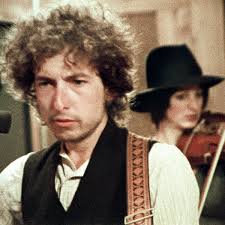
DYLAN WITH SCARLET RIVERA
The material on Desire is heavily influenced by cinematic tropes and themes. The conception of the songs from the album and of the subsequent Rolling Thunder tour are strongly linked to Dylan’s ambitious project to make the part-concert, part-dramatic movie that eventually became Renaldo and Clara. His interest in directing a film had been stimulated by his participation in Sam Peckinpah’s elegiac Western Pat Garrett and Billy the Kid in 1973. The first song to be written for Desire, One More Cup of Coffee, could almost have served as part of Dylan’s soundtrack. Its narrator is an apparently doomed gunfighter who is lying in bed with a mysterious and darkly beautiful gypsy woman, attempting to prolong the moment of prevarication before he meets his enemies. Perhaps Kris Kristofferson’s Billy the Kid could have sung it to his lover Maria (Rita Coolidge) before going to his death at the hands of Pat Garrett. Dylan claimed to have written the song after attending an annual gypsy festival in the South of France in 1975. Certainly the song conveys a strong gypsy/ Mexican ambience. Dylan deepens its atmospheric nature by adding some vocal touches that may well have been influenced by the Jewish ceremonies he participated in as a child – what Allen Ginsberg called …Hebraic cantillation never heard before in U.S. song, ancient blood singing…
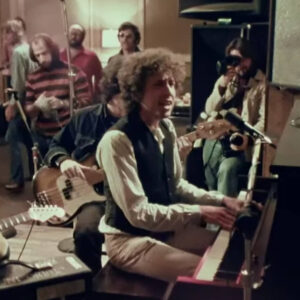
The song’s ‘exotic’ mixture of different musical influences and lyrical mystery has inspired many cover versions by Tom Jones, Robert Plant and The White Stripes and others. Jack White of The White Stripes performed the song as a duet with Dylan at the Ryman Auditorium in Nashville on 20th September 2007. It is also the track from Desire which Dylan has played the most in succeeding years. The Rolling Thunder Live segment of The Bootleg Series includes nine versions of the song, all of them compelling. It was played 108 times on the 1978 World Tour, in an expansively rhythmic arrangement prominently featuring Dylan’s backing singers, and on a number of occasions on the Never Ending Tour between 1988 and 2009.

The chorus is simple but highly evocative: …One more cup of coffee for the road/ One more cup of coffee ‘till I go/ To the valley below… One of the episodes of Theme Time Radio Hour features an entire hour of songs about coffee, from the Inkspots’ Java Jive to Otis Redding’s Cigarettes and Coffee to Blur’s Coffee and TV. The final track features the Glenn Miller Band performing Let’s Have Another Cup of Coffee. The chorus also recalls the Arlen/Mercer composition One For My Baby (One For The Road) which Dylan and the Band played (with apparently improvised lyrics) on The Basement Tapes. The contrast between the mundanity of the sentiment and the highly ambiguous …to the valley below… creates the ominous feeling that dominates the song. The addition of Emmylou Harris’ light, ethereal vocals on the title phrase is a further contrast to Dylan’s ruminative singing.

The portentous atmosphere is also created by the intro, which consists of a strummed acoustic guitar, a short bass solo from Rob Stoner and some entrancing violin lines from Rivera – all suggesting that there will be a tragic outcome. We begin with the gunfighter’s internal thoughts as he looks down at the gypsy girl. The highly romantic opening lines with their intimate and carefully chosen details …Your breath is sweet, your eyes are like two jewels in the sky/ Your back is straight, your hair is smooth on the pillow where you lie… seem to suggest that that what follows will be a declaration of love. But this is undercut quite brutally, as the narrator informs us that …I don’t sense affection, no gratitude or love/ Your loyalty is not to me but to the stars above… It is as if the girl is looking up at her lover but is actually staring right through him up into the dark night. This is a remarkable image of passionate disappointment. Perhaps she really is in love with him but is steeling herself not to show it as she knows that he is about to meet his death. It is as if she is wearing one of the ghoulish masks that Mexicans wear in their annual Die de los Muertos (‘Day of the Dead’). It could even be said that she represents death itself.

DAY OF THE DEAD
We hear a few scattered details about the girl and her family. Her father is …a wanderer and an outlaw by trade… who …oversees his kingdom so no stranger does intrude… and thus appears to be some kind of gang leader. He has clearly taught his daughter many survival skills, including …how to throw the blade… and – perhaps most importantly – …how to pick and choose… But the final line of the second verse makes it clear that the old man is in a parlous state, very probably on the edge of death: …His voice it trembles as he calls out for another plate of food… The inclusion of ‘trembles’ strongly suggests that he is either terminally ill or demented, suggesting that in fact the daughter is in charge of his ‘outfit’. Perhaps it is her who is sending him ‘to the valley below’.
We also hear that the females of the family have psychic gifts: …Your sister sees the future like your mama and yourself… despite her being illiterate: …You never learned to read or write, there’s no books upon your shelf… which enhances our impression of the girl as possessing a natural psychic power. In the final lines it is suggested that she has a considerable sexual appetite: …Your pleasure has no limits, your voice is like a meadowlark… Here the traditional poetic image of the voice of the meadowlark is invoked to suggest that the girl is experiencing a powerful orgasm. This is countered by …But your heart is like an ocean, mysterious and dark… It seems that he has been overwhelmed by her ‘dark powers’ and that he will therefore follow her instructions even – as seems likely – they will lead to his death.

On one level, One More Cup of Coffee is a remarkable evocation of the potentially destructive power of sexuality. The singer is so entranced by the girl that he is willing to venture ‘to the valley below’ without question. Such is the ambiguity of the chorus, however, that the song can be interpreted in various different ways. In fact, the narrator may not be going to his death. He may be gathering strength for some great unnamed enterprise. Alternatively, he may be delaying leaving the girl. Perhaps the ‘one more cup of coffee’ is actually a euphemism for ‘one more sex session’ before he departs. He is clearly mesmerised by her sexuality. Whatever way one takes the song, it is certainly an exploration of the extreme emotions that can be discovered on borderline between lust and love.
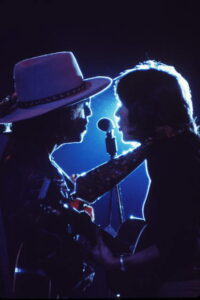
Golden Loom, which was not included on Desire but was recorded by Roger McGuinn for his album Thunderbyrd in 1977, is another song which explores sexual dynamics from an unusual angle. This time Dylan evokes a mythical figure to describe a sexual encounter. The tone and imagery of the song are very different, resembling the work of the romantic poets. But again any semblance of real love is missing here. While the girl in Coffee is dark and dominating, the love object here is just a chimera – perhaps a product of the singer’s imagination. Although it lacks the driving power of the previous song, it has a pleasant melody (again driven by Rivera’s distinctive violin playing) and some interesting images and is one of the earliest examples of Dylan’s interest in classical literature, which would become a major preoccupation in his work of the 2000s.

Golden Loom is a dreamy vision. Dylan begins by setting the scene evocatively, as his narrator gazes out over a maritime scene: …Smoky autumn night, stars up in the sky/ I see the sailin’ boats across the bay go by… We are told that …Eucalyptus trees hang above the street… These trees are native to Australia, although there is very little evidence that this is where the song is set. The narrator then sees the woman approaching him: …Moonlight on the water, fisherman’s daughter/ Floating into my room with her golden loom… Already we may question whether the bearer of the loom is a real person. It seems that this ‘fisherman’s daughter’ is a spirit or an imaginary person who the narrator has dreamed into existence. In Homer’s Odyssey, the nymph Calypso detains Odysseus for seven years on his journey home. While weaving on her loom which has a golden shuttle, she enchants and seduces him. Only when Zeus orders her to do so does she let him go. Maria Muldaur recorded an interesting version of the song in which she addresses it from the female point of view, playing the part of Calypso herself.

CALYPSO AND ODYSSEUS – WILLIAM RUSSELL FLINT
As the dream continues, the narrator and the nymph take part in bonding rituals: …First we wash our feet near the immortal shrine/ Then our shadows meet and we drink the wine… But this reverie is soon rudely interrupted as the narrator sees …hungry clouds up above your face/ Then the tears roll down, what a bitter taste… But then the figure suddenly ‘drifts away’ …on a summer’s day where the wildflowers bloom… again suggesting that she is a figment of his imagination. The reference to ‘hungry clouds’ may be derived from Blake’s prose poem The Marriage of Heaven and Hell: …Rintrah roars and shakes his fires in the burdened air; Hungry clouds swag on the deep… In this imagined world, even the clouds are alive. The surreal imagery continues, as the narrator crosses a bridge …in the dismal light/ Where all the cars are stripped between the gates of night… The mention of ‘cars’ jolts the song into the present day. The abstract phrase ‘gates of night’ is somewhat reminiscent of Dylan’s ‘Gates of Eden’. It describes a secret, mystical and self contained location. Whatever force has ‘stripped’ the cars down remains unknown, but this appears to be an image of desolation.
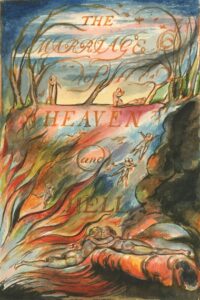
The final lines are preceded by perhaps the song’s most distinctive image: …I see the trembling lion with the lotus flower tail… The image of a ’trembling lion’ suggests a powerful being who is somewhat afraid to act. Lotuses generally symbolise strength, resilience and rebirth, but the narrator is looking at a surreal image which embodies a certain degree of anticipatory fear. We now reach the moment of truth. He lifts her veil and kisses her. But then she vanishes, leaving only …the smell of perfume/ And your golden loom… It seems that the woman is a mere chimera, a product of his imagination. The moment he acts upon his impulses and actually makes physical contact with her, she disappears.
It may be significant that these two songs were the first Dylan composed after the anguished love chronicles of Blood on the Tracks. The gypsy girl and the Calypso figure are very different characters. One is highly physical and sensual while the other is ethereal and otherworldly. But both are essentially unreachable and unfathomable. At this point Dylan’s ‘love songs’, which had once (in songs like Don’t Think Twice, It’s All Right or One of Us Must Know) been so philosophically distanced, now seem to inspire fear, fantasy and emotional chaos. The decision to collude with theatre and cinema director Jacques Levy in writing his next group of songs may have been an attempt to achieve a new, more detached perspective on ‘matters of the heart’. The songs they wrote together covered a variety of genres and musical styles, with their love songs ranging between tragic and comic perspectives. It seems that at this point Dylan having immersed himself in the intensely painful emotions that characterized much of Blood on the Tracks, may have needed another perspective to inject more balance and humour into his work.

Some of the Dylan/Levy songs, like Hurricane and Joey, are concerned with contemporary life stories seen from a socio-political viewpoint. Others, like Isis and Black Diamond Bay, are extended surreal narratives mixing fantasy with dark humour. A couple of the songs they wrote were purely light hearted efforts. Rita May, which did not make the album but appeared on a ‘B’ side, is a raucous exercise in rhythm and blues, based on the 1957 rockabilly raver Bertha Lou, recorded by Johnny Faire and Dorsey Burnette. Dylan slows down the tune a little, so that it resembles the work of Jerry Lee Lewis. Jerry Lee himself recorded a steaming take of the song. On the recording that appears on Disc One of the Rolling Thunder Live Bootleg Series set from the SIR Studios Rehearsals in 1975, Dylan and his band (with Ronee Blakely on prominent backing vocals) really attack the song, with Blakely adding a tongue in cheek verse about …a boy with dreamy eyes… The song was only performed once in concert, at The Warehouse in New Orleans on 3 May 1976, with bassist Rob Stoner supplying backing vocals.

The basic joke behind the song is that the singer claims that, rather than admiring her physical attributes, he is interested only in her mind. This is of course a reversal of the usual approach of highly sexualised post-Elvis rockabilly material. He tells her that…You got your body in the way… The song relies on its cleverly humorous rhyming for much of its effect, especially when Dylan sings …You’re so damn nonchalant/ It’s your mind that I want… and later …I don’t have to go to college ‘cos you are the book of knowledge… He also claims that …You got me huffin’ and a puffin’/ Next to you I feel like nothin’ and …You got me burnin’ and I’m turnin’/ But I know I must be learnin’… Throughout the song the singer maintains that it is the girl’s intellect that attracts him. But this may well be just a ruse that he is using to make a physical connection with her – a comically exaggerated ‘chat up line’ that he is using to try to attract this intellectual (and presumably feminist) female. This is made more obvious in the bridge section, when the singer po-facedly tells us that …All my friends keep telling me that if I hang around with you I’ll go blind… This refers to the ‘old wives’ tale’ that masturbation causes blindness, suggesting that he really is sexually obsessed with her. Or perhaps he has never really met her, but ‘admires’ her photos from afar.
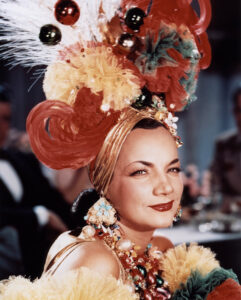
CARMEN MIRANDA
Rita May is an amusing parody of contemporary sexual mores, while the more straightforward Mozambique, which provides some light relief on the album, is a whimsical pastiche of Hollywood musical songs of the 1940s and 50s. The song has a light ‘Latin’ feel reminiscent of performers like Carmen Miranda (especially her song Chica Chica Boom Chic). The name ‘Mozambique’ appears to have been picked at random, more for its sound than anything else. It has been rumoured that Dylan and Levy chose the name as part of an exercise in seeing how many rhymes they could follow ‘ique’ with. Here we get cheek’, ‘unique’, ‘week’ and ‘peek’. It is arguable that the choice of the name was unfortunate, as the real country of Mozambique in Africa had spent most of the previous decade engaged in a bitter and bloody war of liberation against its colonial oppressors the Portuguese. Some listeners – desperate, perhaps, for Dylan to return to political songwriting – interpreted the song as a sarcastic comment on this war and perhaps the state of the world in general. But this is largely wishful thinking. In fact the song is a light confection, which was played on most of the gigs in the second Rolling Thunder tour of 1976, where it provides the band and audience with some fun and light relief from the wordier, more serious material.

The song is deliberately written in slightly ungrammatical English, as if it is being sung by a performer whose first language is Spanish or Portuguese, beginning ….I like to spend some time in Mozambique… Later we get …plenty time for good romance… ‘Mozambique’ itself is portrayed as a kind of Hollywood paradise, where …the sunny sky is aqua blue… and where ‘all the couples’ are …dancing cheek to cheek… (a reference to the song Cheek to Cheek from the Astaire/Rogers vehicle Top Hat from 1935). In this fantasy land these ‘lovely people’ appear to live permanently on a beach. At times the narrator sounds like he is trying to sell us a holiday. We get ‘cheesy’ remarks like …It’s very nice to stay a week or two… and …There’s lots of pretty girls in Mozambique… It is strongly hinted that we may well find love there: …Whispering a secret emotion/ Magic in a magical land… We are told that on this glorious vacation we will be …among the lovely people living free… It is, of course, all ridiculously ‘corny’ but the melody is strong and the execution of the performances is generally immaculate, with Scarlet Rivera’s violin again dominating the sound. The studio version is made more atmospheric by the addition of trumpets, mandolin and bouzouki.
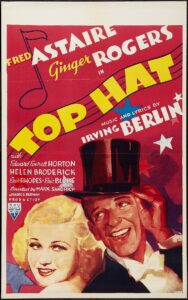
The tragic love song Romance in Durango also contains strong elements of pastiche. It is almost as if Dylan and Levy have tried to cram in as many stereotypical references to Mexico as possible. We get scenes in a cantina, a fiesta, the desert and a corrida and references to the fandango, tequila, a ‘padre’, golden earrings, ancient Aztec ruins and the Mexican revolution. This is not so much a song about Mexico as a song about a movie set in Mexico, possibly a ‘spaghetti western’ with an ambivalent anti-hero. Clint Eastwood would be a shoe-in for the part of the nameless narrator – a ‘man with no name’. The elements of gun fighting, outlaws, lovers on the run with lawmen on their trail are also reminiscent of aspects of the revisionist Western Pat Garrett and Billy the Kid. Yet this is no lighthearted ditty like Mozambique. The song’s stirring melody, its resonant imagery, its pacing and dramatic flourishes and its narrative economy all contribute to the creation of a genuinely tragic and moving story, even if those elements are dictated by cinematic conventions. It was part of the standard set list in the first Rolling Thunder tour, although was played less often in 1976. Since then it has been played only once, to a surprised but highly delighted audience at the Hammersmith Apollo in London in 2003. The live versions of the song tend to be slightly faster and harder edged than the studio recording.
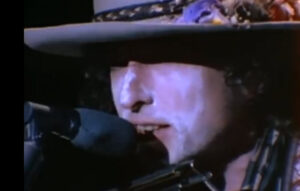
…Hot chili peppers in the blistering sun, dust on my face and my cape… is one of Dylan’s most resonant opening lines, setting the tone of the song – with its elements of ‘hot passion’ – perfectly. By relating the story in the present tense Dylan gives great immediacy to the narrative. Up until the tragic ending, the narrator sounds optimistic; although we may soon suspect that this feeling is misplaced. He addresses the song to his lover Magdalena, with whom he is trying to escape from the forces of law and order, continually trying to reassure her that they will escape. He confesses that has …sold my guitar to the baker’s son… but promises to buy another one so he can play for her when they reach freedom. The song has a rousing chorus, some of which is in Spanish: …No llores, mi querida/ Dios nos vigila (Don’t cry, my dear God is watching over us)/Soon the horse will take us to Durango/ Agarrame, mi vida (Hold me, my love, my life)/ Soon the desert will be gone/ Soon you will be dancing the fandango… Durango is the area of Mexico where Pat Garrett was filmed. The narrator seems to believe that he and Magdalena will be free when they get there.
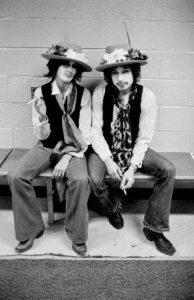
As the journey continues …past the Aztec ruins and the ghost of our people… the narrator begins to reflect on why he is wanted by the authorities. The questions he asks: …Was it me that shot him down in the cantina?/ Was it my hand that held the gun?… are compelling because they take us into his inner thoughts, which have just been focused on …the bloody face of Ramon… (the murder victim). The narrator’s questions seem to cast doubt on his involvement, but he is merely trying to justify himself in front of his girl. He then goes into a reverie in which he imagines their life in Durango, sitting in the shade enjoying a bullfight and drinking tequila in the location where ‘their grandfathers’ rested before taking part in the Battle of Torreon during the Mexican revolution. He also imagines their future marriage, at which …the padre will recite the prayers of old… He pictures Magdalena with diamonds in her wedding gown and himself dressed up smartly, with …new boots and an earring of gold… At the climax of this fantasy he has a divine vision: …The face of God will appear/ With his serpent eyes of obsidian… This luminous image of God appears to correspond to that of the Aztec deities Quetzalcotl the serpent god and Tezcatlipoca, the god of obsidian (the material from which the Aztecs made mirrors).

QUETZALCOTL
In the final verse, however, the reality of the situation hits home …Was that the thunder that I heard?… the narrator asks himself. Then he tells us that …my head is vibrating, I feel a sharp pain… Despite his previous boasts and fantasies, we know by now that he has been hit. He spells this out to us like a character in an old fashioned melodrama, asking another rhetorical question: …Oh can it be that I am slain?… He hands the gun to Magdalena. Then, in a beautifully compressed final flourish he tells her to: …Look up in the hills, that flash of light/ Aim well, my little one, we may not make it through the night… The image of the flash of light in the hills is particularly cinematic. It is obvious that he – and very probably Magdalena as well – are now doomed. What remains with us, however, is not their deaths, which will occur ‘off screen’ but the narrator’s fanciful visions of their future life. But the God which appears to rule their lives seems to be a harsh and fearful being.

Romance in Durango can also be linked to another film genre – that of ‘lovers on the run’ – as in the 1967 film Bonnie and Clyde, Badlands (1973) and Sugarland Express. In such films the couples fleeing from the law are usually played by especially attractive actors, their relationships are highly romanticised and they frequently appear to take on the mantle of ‘rebels against society’. The genre turns them, therefore, into heroes. The narrator of Durango wins us over with his extreme romanticism, but surely we suspect from the outset that he and his lover are doomed. The song is thus a highly successful genre piece. But reading ‘deeper meanings’ into it, as some commentators have done, is a more dubious exercise. The story itself is a simple one, distinguished by the narrator’s self-serving and dramatic rhetoric. Dylan projects himself into the role of the protagonist with great verve and imagination. But he does not attempt to use the song to comment on social, personal or religious matters.

FAYE DUNAWAY AND WARREN BEATTY IN ‘BONNIE AND CLYDE’
The same cannot be said for Oh Sister, which is the only Dylan/Levy song lacking in strong cinematic or theatrical elements. It is a sad, wistful song, delivered at a sonorous pace, with a number of extended vocal effects. The interplay between violin and harmonica is especially effective here in tugging the heart strings. There are only three short verses and a bridge but the song usually lasts for at least four minutes. On Desire Emmylou Harris’ contribution is mixed up high so the track is virtually a duet. Having both male and female voices together adds an interesting dynamic, given the fact that the song is a direct address to a woman, or perhaps to women in general. The use of the word ‘sister’ seems to be a nod to feminists. Dylan appears to be lamenting the tragic misunderstandings between men and women that can occur with regard to sexual politics. At the same time, the song is also apparently directed at an individual woman with whom the narrator has had a relationship. He delivers various warnings and admonitions to her, but these are almost certainly futile.

The language of the song is fairly simple and lacking in strong concrete images. Dylan plays with religious and social concepts in a rather disarming way. The opening …Oh sister when I come to lie in your arms/ You should not treat me like a stranger… strongly suggests a sexual connection. We can presume that the woman is not the narrator’s actual sister but that he is addressing her in this way as a term of respect. The ‘family’ analogy is continued with …Our father would not like the way that you act… There is a strong implication that he is referring to a ‘heavenly father’ here. He appears to be implying that men and women are ‘brothers and sisters under God’. But his tone is oddly didactic, even dictatorial. The first verse ends with a warning to the woman that …You must realise the danger…. In this case the ‘danger’ appears to be that she will reject him. This is rather contradictory, given the respectful way he addresses her. It is as if he is invoking some kind of divine judgement to persuade her to stay with him.
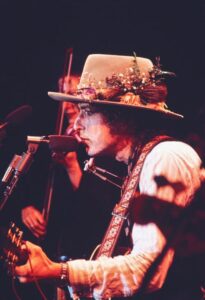
As the song develops the narrator’s pleas become more insistent. The tone he adopts is slightly archaic as he attempts to persuade her that he is ‘worthy’: …Oh sister, am I not a brother to you/ And one deserving of affection…. This is a rather weak and arguably pathetic attempt to win her affection. He appears to be trying to win her over by lecturing, or possibly hectoring, her about his supposed ‘right’ to her love. He continues with the same rhetorical device: …And is our purpose not the same old desert/ To love and follow his direction… The use of the archaism ‘desert’ to indicate fate in a rather negative way, as in the phrase ‘just deserts’, is particularly striking here.
The short bridge section is perhaps the most puzzling in the song, beginning with the slightly odd expression …We grew up together from the cradle to the grave… which again positions the woman as his ‘sister’. He then suggests that they have been through some kind of religious experience together: …We died and were reborn and yet mysteriously saved… Finally he implores her not to turn him away when he calls on her. In his final desperate plea, the highly evocative if somewhat abstract…Time is an ocean but it ends at the shore/ You may not see me tomorrow… he may be trying to appeal to her by pointing out how short life is. But he may also be delivering an implied threat to walk away from her if she does not respond in time. We can be pretty certain, however, that all his efforts will be in vain.

In the post-Blood on the Tracks songs that centre around love, romance and commitment, Dylan tries a range of different approaches to matters that, for him, are clearly unresolved. As ever, he uses various personas, historical settings and dramatic devices to approach an area that he once dealt with in such a self-assured way but which now seems to have morphed into many different dimensions – delightful, nostalgic, comical, sad and often darkly confusion. Over the next few years this uncertainty and insecurity will lead him towards adopting the ‘safety blanket’ of a ’born again’ religious experience in the midst of perhaps the most turbulent phase of his creative life.
LINKS….
STILL ON THE ROAD – ALL DYLAN’S GIGS



Leave a Reply